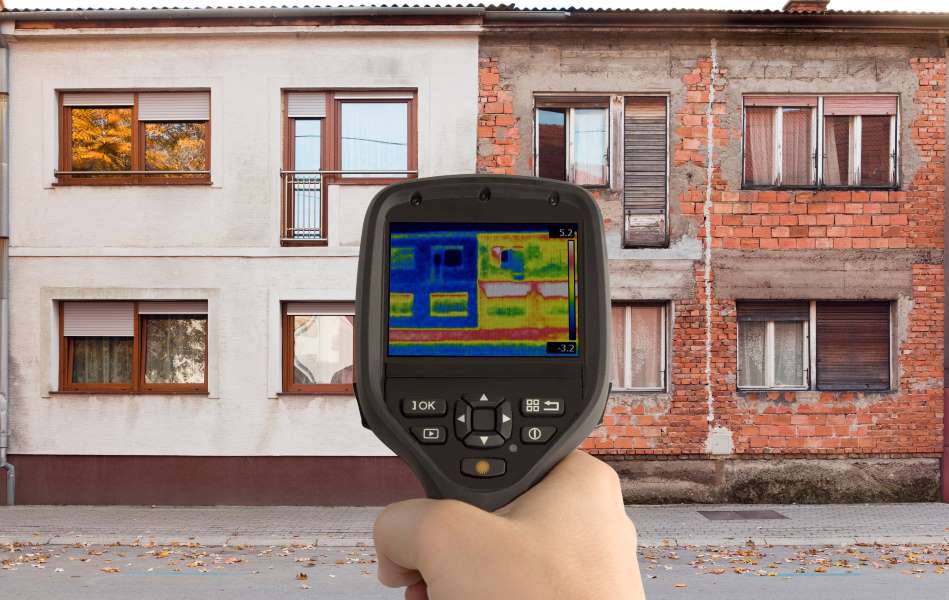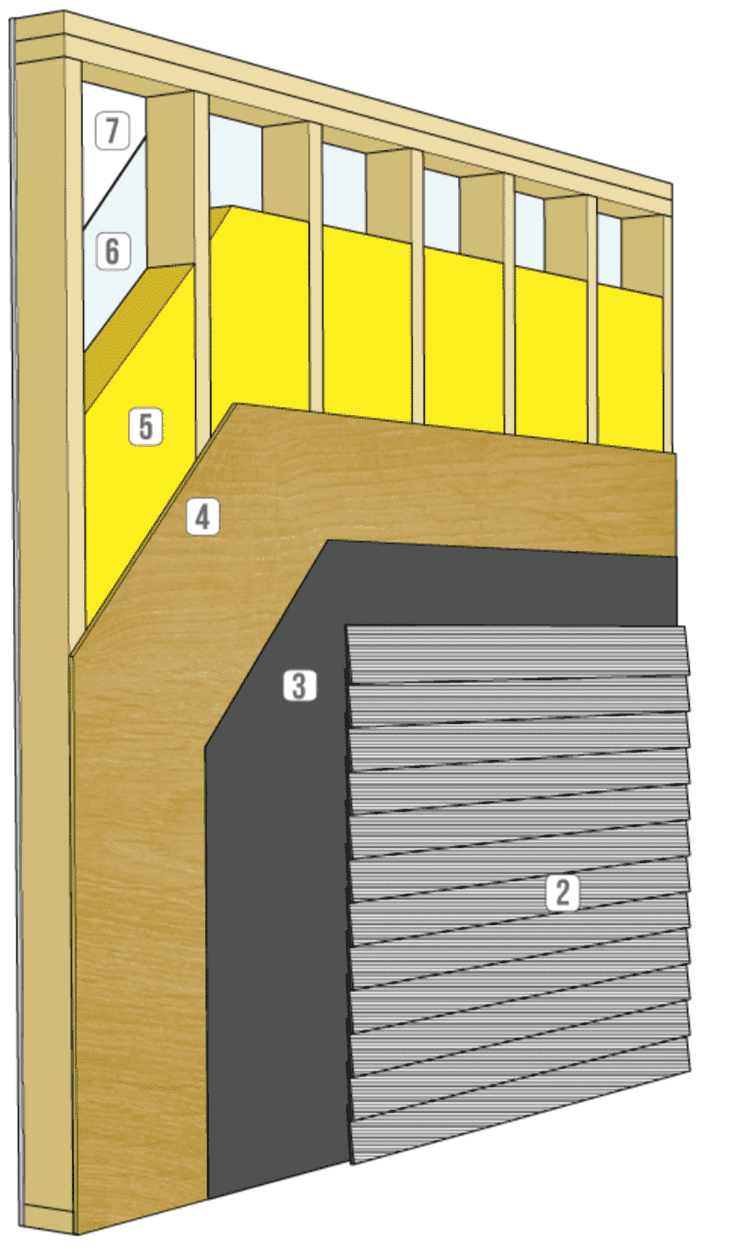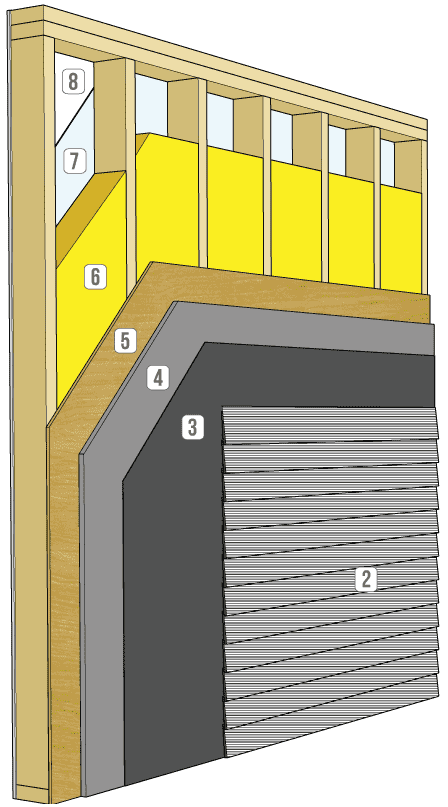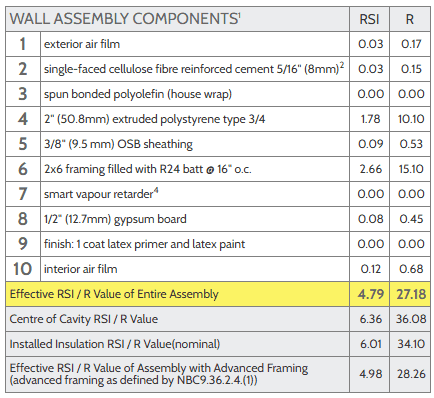
Have you ever bought a new phone that made promises like “up to 18 hours of battery life watching videos” only to be searching for a charger by mid-afternoon? Or heard promises about the fuel milage of the newest car models while in reality its dependant on a variety of conditions. Just ask any EV driver about their car’s range in the winter.
These advertised results are idealized and usually achieved in a lab environment that is far different from real world conditions. You might be surprised to hear that insulation has the same issue.
Just because the label on an insulation product says it provides a certain R-Value, that doesn’t mean the building it is installed in will perform at that level. All the variables of a wall assembly can make a big impact on the energy performance, comfort levels, energy bills, and carbon footprint of a building.
Let’s break down:
- What is a R-Value
- The difference between nominal and effective R-Values
- Real-world, eye-opening examples of these differences
- How to boost insulation performance to the intended level of performance.
What is a R-Value?

R-Value is the measurement of how well a material resists heat flow, whether that’s keeping heat inside of a space or keeping cold from entering a space. The higher the R-Value, the less energy is needed to keep a space comfortable year-round.
Another unit that can be used to measure heat flow resistance is RSI. The two can be used interchangeably and it is easy to convert one unit to the other:
- RSI * 5.678 = R-Value
- R-Value / 5.678 = RSI
For example, a R-Value of R-5 is roughly equal to a RSI of 0.88.
Technical tip: The formula for calculating R-Values is (ft²·°F·h)/BTU. This formula tells us how much heat transfer is slowed by a material or assembly.
Technical tip: The formula for calculating R-Values is (ft²·°F·h)/BTU. This formula tells us how much heat transfer is slowed by a material or assembly. Check out our article on how insulation works to learn more.
What is the difference between an Effective R-Value and Nominal R-Value?
A nominal R-Value is the thermal performance rating provided by the manufacturer and is written on the label of the insulation. One way to think of it is it’s the best case scenario.

The effective R-Value is what you get in reality and takes a variety of variables into account. A few of these variables include the framing spacing on center, fasteners, thermal bridging, air gaps, number of windows, type of exterior finish, etc.
Individual products don’t typically have effective R-Values as effective R-Values measure the actual thermal performance of the full wall assembly.
It is like trying to measure how spicy a meal is by adding up the Scoville ratings of each ingredient. It doesn’t really work. Some ingredients combined may mellow the dish out, others may intensify the spice. The final spice level depends on how it all blends together.
Real World Examples of Effective vs Nominal R-Values
Wood Framing
Let’s break down a real residential wall assembly to understand how the nominal and effective R-Values differ.


Most of the thermal resistance in this assembly comes from:
- 2×6 wood studs spaced 16” on center (O.C.)
- R-24 fiberglass batt insulation
While the nominal R-Value of this assembly is R-24, the effective R-Value is only R-17.08. That is 30% lower than the nominal R-Value. This difference can make a huge impact on:
- Utility bills as more heats escapes the building in the winter and enters in the summer
- Rooms may feel drafty and uncomfortable
- Your furnace and mechanical systems will wear out faster & use more energy as they need to turn on and off more frequently than they should
Now let’s see what happens when a layer of 2” exterior insulation is added to the assembly. This eliminates thermal bridging (heat loss from heat escaping through the points of least resistance aka the wood framing in the wall) by covering the entire wall area with continuous exterior insulation, not just the cavities in between the studs like the batt insulation.


This upgrade changes the nominal R-Value to R-34.10 and the effective R-Value to R-27.18. This upgrade helps retain indoor comfort, lower heating and cooling costs, and reduce carbon emissions. It’s a win on all fronts and helps give homeowners what they paid for. If they see R-24 insulation of their spec sheet, they are expecting to get an EFFECTIVE R-24.
Steel Framing
Steel framing is widely used in commercial construction and is growing in popularity in residential construction. While it’s strength and fire-resistance are ideal, it is hundreds of times more conductive to heat loss through thermal bridging compared to wood.
The American Society of Heating, Refrigerating and Air-Conditioning Engineers (ASHRAE) conducted studies on a variety of steel-framed assemblies including:
- A wall with a nominal R-Value of R-11 was found to have an effective R-Value of only R-5.5.
- A wall built with 8” steel studs and R-25 cavity insulation was found to have an effective R-Value of only R-7.8.
Without continuous exterior insulation, steel framing can almost cancel out the benefits of batt insulation.
The U.S. Department of Energy’s Oak Ridge National Laboratory (ORNL) did a study on different exterior finish systems on an identical steel-framed wall to see the difference in nominal and effective R-Values.
First, they tried an assembly with a brick veneer finish as it boasts a stronger R-Value than many other types of exterior finishes:
- Nominal R-Value: R-11
- Effective R-Value: R-6.98
The effective R-Value ended up 37% lower than the nominal R-Value.
When the exterior finish was changed to an exterior insulation and finish system (EIFS), the effective R-Value was 87% higher than the brick veneer wall. This demonstrates that the location of insulation is just as important as the type or amount of insulation used.
Final Thoughts
When it comes to insulation, the number on the label—nominal R-Value—only tells part of the story. Real-world conditions like framing, thermal bridging, and installation quality all affect actual performance, known as the effective R-Value.
Ignoring this gap can lead to:
- Higher energy bills
- Uncomfortable interiors
- HVAC strain and premature wear
- Missed energy efficiency targets
The solution?
- Add continuous exterior insulation
- Reduce thermal bridges
- Use smarter systems like SIS Panels
- Leverage tools like the Canadian Wood Council’s Effective R-Value calculator
These upgrades are low-effort but high-impact—and they ensure your design performs as promised.
Remember: buildings don’t live in labs. They live in the real world. That’s why effective R-Value is the number that truly matters.
Sources
https://blog.buildmeetsworld.com/nominal-vs-effective-r-values
https://web.ornl.gov/sci/buildings/docs/Oak-Ridge-Federal-Tests-Report.pdf
https://web.ornl.gov/sci/buildings/docs/factSheets/Insulation-FactSheet-2008.pdf
https://cwc.ca/en/design-tools/effective-r-calculator/how-to-use-this-calculator/
